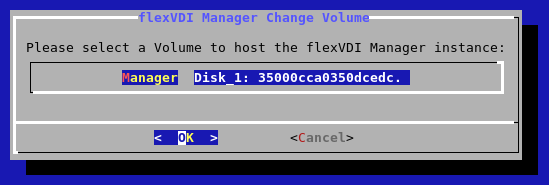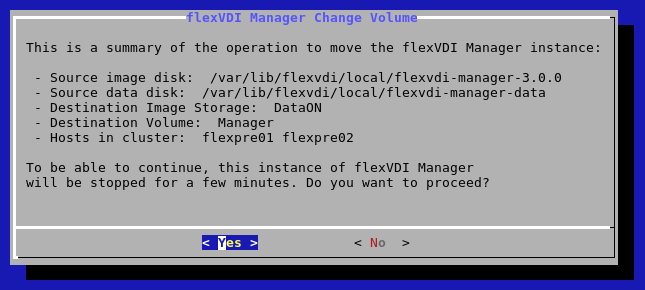flexVDI Manager Clusterization
Prerequisites
This section shows how to configure flexVDI Manager in High Availability. After this, if the flexVDI Host that is running the flexVDI Manager fails, another instance of the flexVDI Manager will be started on another host automatically. The requirements to clusterize are:
- Having registred at least two flexVDI Hosts in the flexVDI Manager. This task can be done through the flexvdi-config command.
- Having shared storage accessible by the flexVDI Hosts: SAS, ISCI, ...
- Having the same virtual bridge (for instance virbr0) connected to the same LAN in all flexVDI Hosts.
- It is highly recommended to have a dedicated network interface for storage.
Storage configuration
You must use disks shared between the flexVDI Hosts to store the disk image of the instance flexVDI Manager, so that it can be started in any of them. To do this, you must create an Image Storage, and within it a Volume. This task must be done with the flexVDI Dashboard application. Read the the section on this guide about configuring storage objects to learn more. Note that you can store the flexVDI Manager in an Image Storage that is reachable by only a subset of all the Hosts. In that case, only those Hosts will be able to start a flexVDI Manager instance.
flexVDI Manager Clusterization
Once the shared Volume has been created, you can clusterize your instance of flexVDI Manager executing flexVDI Config on any host.
You can move the flexVDI Manager instance to a different Volume at any time following this very same process.
- Select Manager in the main menu.
- Select Move option.
- Enter the flexVDI Manager instance password.
- Select the Image Storage where flexVDI Manager disk image is to be stored.
- Select the Volume where the disk image will be stored.
You'll then see a window with the information about the flexVDI Manager Clusterization process: source location of the flexVDI Manager instance, destination volume, and flexVDI Hosts in the cluster that can reach that location. Click "Yes" to proceed.After the clusterization has finished, a window will be displayed informing about the outcome of the operation.
You can check the configuration from any flexVDI Host by accessing the /etc/flexvdi/flexvdi-agent-watchdog.conf file. Its content should be similar to this:
{ "ipaddress": "10.111.1.181", "vmname": "flexVDI_Manager", "vmimage": "/flexvdi/image_storages/myImageStorage/myVolume/flexvdi-manager-2.2.17", "vmdata": "/flexvdi/image_storages/myImageStorage/myVolume/flexvdi-manager-data", "vmbridge": "virbr0", "vmvlan" : "", "vmpassword": "adsfas32", "instance": "00", "ha_mode" : "clustered", "host_list": ["flexhost1", "flexhost2"], "ocfs2_primarydisk_id": "beaf11", "ocfs2_secondarydisk_id": "", "ocfs2_volume_id": "myVolume", "ocfs2_imagestorage_id": "myImageStorage", "storage_mode": "ocfs2"} |


